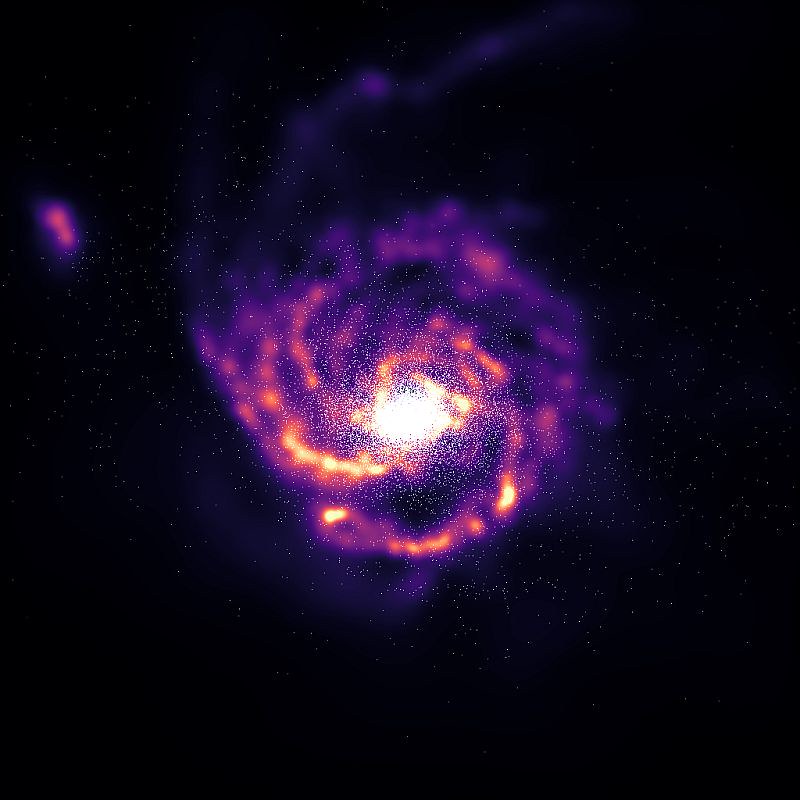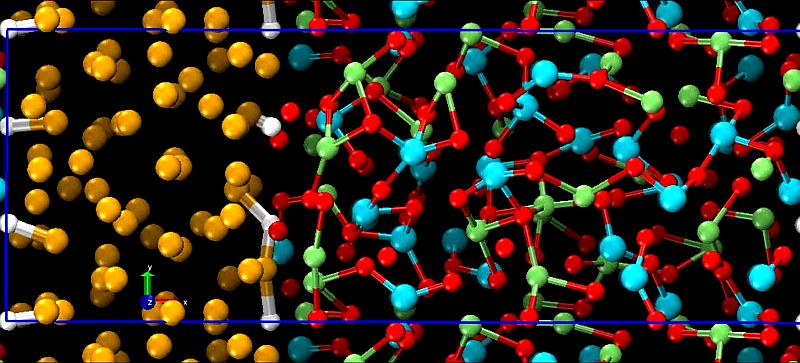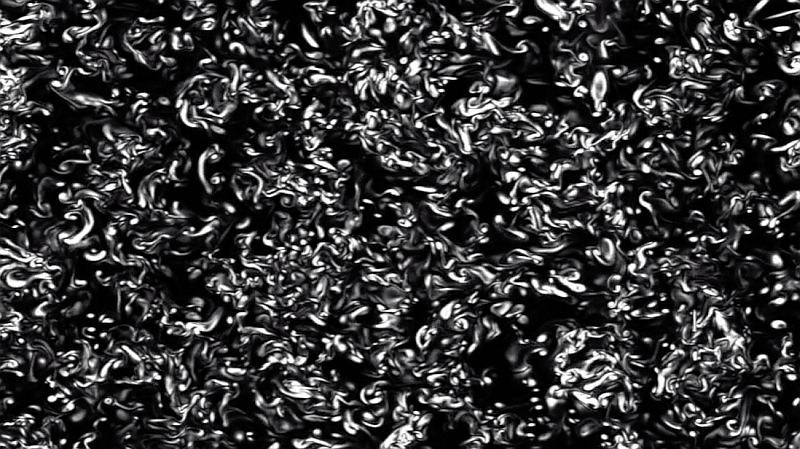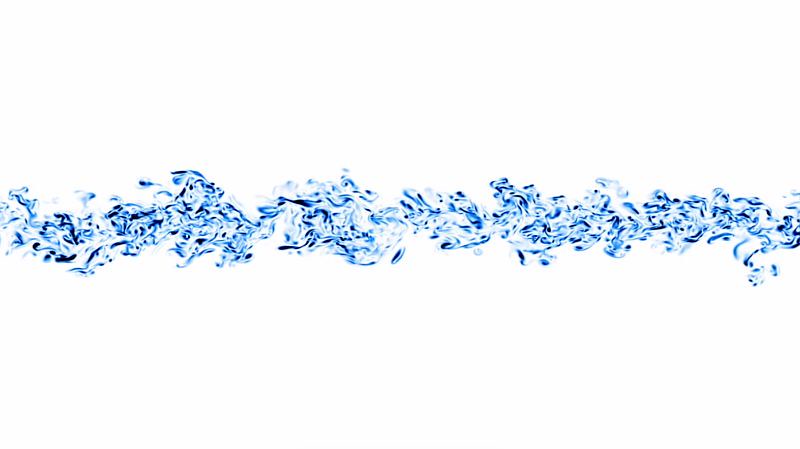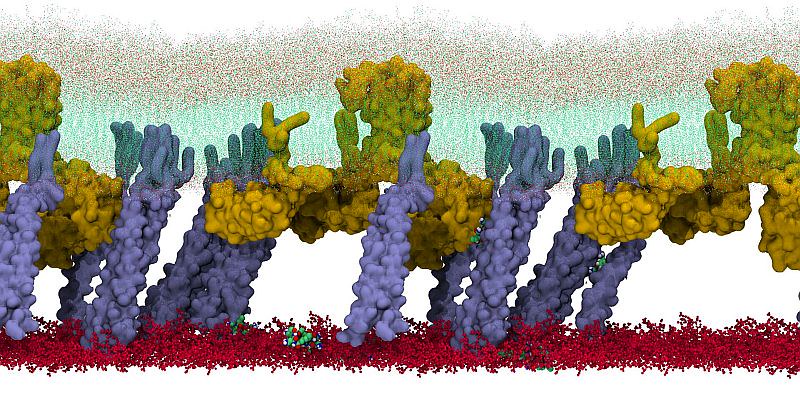1. The chain-melted phase now understood from simulating potassium. Chains can be seen flowing through the host-guest structure.
Victor Naden Robinson, The University of Edniburgh, Physics and Astronomy
Some elements form a host-guest structure with 1D chains under compression, and when heated these chains can "melt". Here we attempted to simulate this phenomenon to understand the nature of this order-disorder transition. Starting from ab initio methods we developed a force field in order to simulate a large number of chains and map out the correlation between different chains and along individual chains, revealing the full 3D nature of the order-disorder transition.
2. Electron localization function (ELF) 001 cuts through hot dense liquid lithium.
Victor Naden Robinson, The University of Edniburgh, Physics and Astronomy
100 cuts through high pressure and temperature liquid lithium showing the electron localization function (ELF) isosurface from 0.0 (blue) to 1.0 (red). Off site charge density appears to localize between atoms with no nuclei in their centre.
3. Simulating disk galaxies inside a cosmological volume
Dr. Weiguang Cui, IFA, University of Edinburgh
This movie shows a simulated disk galaxy which is similar to our milk way galaxy in both mass and size. The purple-red color map shows the smoothed gas distribution in side the galaxy, while the white dots represent each simulated star particles.
The researcher, with their collaborator, run a very high-resolution simulation in Archer to search for disk-like galaxies and to understand their formation within a cosmological content. This simulation includes a very complex model which mimic the most baryon processes happened in the Universe.
The movie shows an example of the typical disk-like galaxy formed in the simulation. The team is working right now on understanding its formation through looking back to its complete history.
4. Store Glacier calving in response to melt undercutting
Dr Joe Todd, Geography & Sustainable Development, University of St Andrews
The release of icebergs from glaciers which flow into the ocean ("calving"), is a process which is highly sensitive to climate change, and a possible major contributor to future sea level rise. We use the "HiDEM" model, which represents glaciers as connected ice blocks, to simulate how iceberg calving is affected by climate processes. This animation shows an underwater view of the response of Store Glacier, west Greenland, to undercutting of the glacier front by warm ocean water. This warm water melts glacier ice, with fastest melt rates at the base. This melt undercutting destabilises the glacier and promotes iceberg calving. This is a major source of ice loss from the Greenland Ice Sheet. At the front, Store Glacier is half a kilometre thick, and each cube of ice in this animation contains enough ice to fill 3 Olympic-size swimming pools.

5. Turbulence-resolving simulations of a utility-scale offshore wind farm, highlighting the flow structures and turbulence of turbine wakes
* * * Winning Early Career Researcher entry * * *
Dr Georgios Deskos, Imperial College London
Coherent (vortical) structures of utility-scale offshore wind turbine wakes, interacting with each other and the ambient atmospheric turbulence.The present simulation was performed on ARCHER using the high-fidelity, high scalability wind farm simulator, WInc3D. The wind turbines are modelled using an enhanced actuator line model. Photos are not enhanced.
6. Cavitation bubble collapse
Mr Duncan Dockar, University of Edinburgh, School of Engineering
Cavitation is the phenomenon where a bubble can spontaneously form within a liquid due to a local reduction in pressure. When these cavitation bubbles collapse, they release a high-speed liquid jet which can result in pitting of the nearby solid surface. This can be a major problem where the repeated formation and collapse of cavitation bubbles over many thousands of cycles can cause significant structural damage, particularly in turbomachinery. However, at the nano- to micro-scale there are potentially beneficial applications for cavitation, such as the cleaning of high-precision micro-electronic sensors.
Our Molecular Dynamics (MD) simulation shows the jet formed from a collapsing cavitation bubble subjected to a shock wave, and the resulting damage to the nearby silicon substrate. We hope this research will further understanding of how pitting occurs in solids, and the conditions to reduce the effects of cavitation erosion.
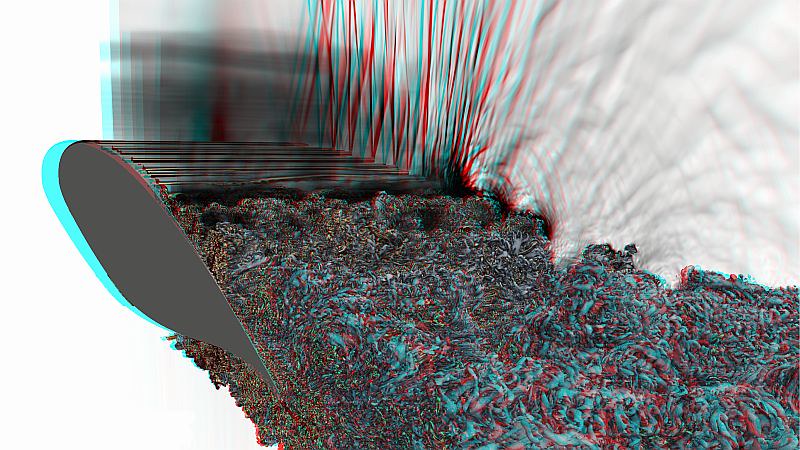
7. Stereoscopic visualisation of vortex structures showing Q-criterion surfaces coloured by vorticity. Strong pressure gradients are indicated by black regions.
Dr Markus Zauner, University of Southampton, AFM Group
Laminar-flow profiles aim to maintain laminar boundary layers for a large part of the airfoil to increase the aerodynamic performance of next-generation aircraft wings. At typical speeds of modern airplanes around 85% of the speed of sound, supersonic regions occur over wings. It is of great interest to study the interaction of shock waves with the wall-bounded flow, as this can lead to severe flow separation or undesirable phenomena like wing buffeting.
Direct numerical simulations were carried out using more than five billion grid points resolving even small turbulent structures. The image above shows the turbulent wake of a wing section at a Reynolds number of half a million, where black regions indicate strong pressure gradients across shock waves or acoustic waves. Stereoscopic visualisations give a great impression of three-dimensional vortex structures using simple red/blue 3D glasses.

8. Hydrogen partitioning during Earth's core-mantle differentiation
Dr Li Yunguo, University College London
The ab initio molecular dynamics trajectories of hydrogen shows that most hydrogen atoms will be partitioned into the core materials at conditions simulating the Earth's core-mantle differentiation process. This simulation clearly demonstrates the siderophile ("iron-loving") nature of hydrogen, and implies that the Earth's core can be a reservoir of hydrogen.
9. Hydrogen partitioning during Earth's core-mantle differentiation
Dr Li Yunguo, University College London
The ab initio molecular dynamics trajectories shows that most hydrogen atoms (white balls) stay in the core material (liquid Fe), while few go into the mantle material (silicate melt) at conditions simulating the Earth's core-mantle differentiation process. This simulation clearly demonstrates the siderophile ("iron-loving") nature of hydrogen, and implies that the Earth's core can be a reservoir of hydrogen.

10. Artistic representation of an angle-resolved photoemission spectroscopy experiment
Mr Nelson Yeung, University of Warwick, Physics Department
An experiment that measures the energy and momentum of electrons in tungsten diselenide. The gold coloured rods and blocks are electrodes made from platinum, which are connected to a power source. The green block is boron nitride, with 3 layers of 2D tungsten diselenide sitting on top of it. The grey atoms at the top are graphene, which is in contact with the electrode. This setup is essentially a capacitor which gives rise to the accumulation of charge in an area of the tungsten diselenide when a voltage is applied to the electrodes. A focused ultraviolet beam is fired at the tungsten diselenide which causes electrons (red balls) to eject from it. The energy and momentum of the ejected electrons are then measured. Computer simulations were used to simulate the results of this experiment.
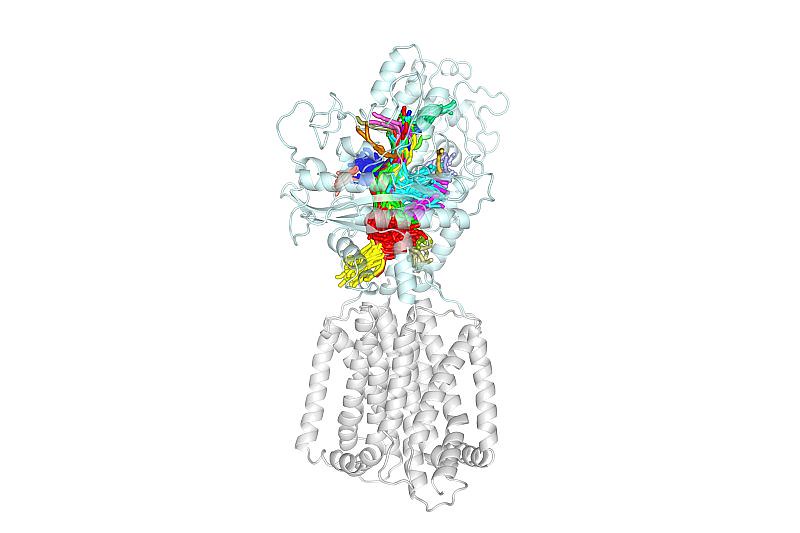
11. Tunnels throughout the extracellular domain of Patched1
T. Bertie Ansell, Oxford University
The Patched1 receptor is a key tumour suppressor membrane protein in the Hedgehog signalling pathway. Recent structural and biochemical studies suggest Patched1 may function as a putative sterol transporter in order to inhibit the Class F G-protein coupled receptor Smoothened. Atomistic molecular dynamics simulations of the Patched1 extracellular domain, bound to a cholesterol molecule, were performed under ARCHER HecBioSim allocated computational time. These simulations were used to assess formation of dynamic tunnels throughout the extracellular domain which we demonstrated collapse upon binding of Sonic Hedgehog ligand cholesterol attachment (Rudolf et al. 2019, Nat. Chem. Biol). The image shows an overlay of Patched1 extracellular domain tunnels on the full length Patched1 protein. We identify tunnels which egress proximal to the membrane region and through two novel side portals. Tunnels are shown as midpoint through the tunnel and coloured by tunnel cluster.

12. Interaction between bubbles and turbulence in pool boiling system
Linlin Fei and Kai H. Luo, Department of Mechanical Engineering, University College London
This image shows 3D high-resolution direct numerical simulations of pool boiling process using an advanced cascaded Lattice Boltzmann method. The bubbles are in green and the high temperature regions are marked in red color. Multi-scale phenomena and turbulence fluctuations can be clearly seen from perspectives of the bubble size distributions and the bubble location distributions, respectively. The high-temperature regions dragged by the rising bubbles indicate the enhanced heat-transfer due to the existence of phase-change.

13. Non-continuum gas flow in tight sandstone
Dr Lianhua Zhu, Department of Mechanical and Aerospace Engineering, University of Strathclyde
Gas flows in the tight sandstone and shale are non-continuum in nature. The conventional pore-scale computational fluid dynamics methods fail to describe such flows and we need resort to a statistic description, by tracking the probabilities of finding a gas molecular flying with a specific velocity at a specific location. Because there are so many possible velocities and locations, we need a supercomputer like ARCHER to solve the underling equation. This image shows the one of the simulation results obtained with a massively parallel simulator we developed and optimized on ARCHER. With over 20,000 CPU cores, the simulator took only 5 minutes on ARCHER to get the solution.
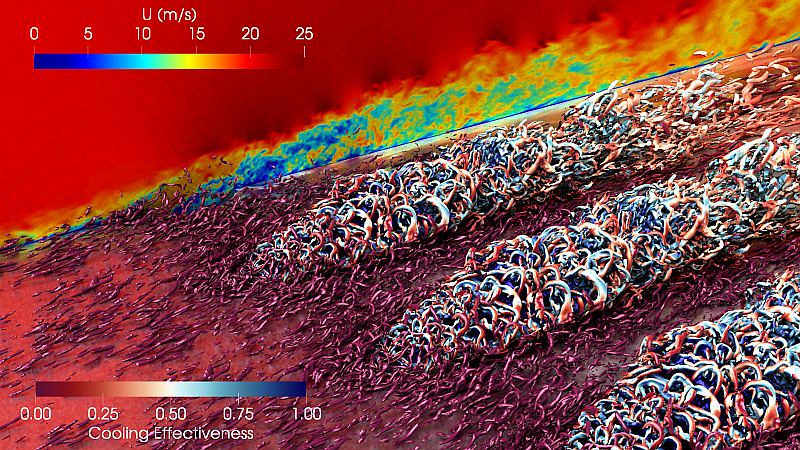
14. Turbulent structures and coolant mixing downstream of a single-row of cooling holes
Christopher Ellis, Loughborough University, Aeronautical and Automotive Engineering
The image presents the Large Eddy Simulation solution of complex turbulent mixing of coolant downstream of a single-row of cooling holes. Turbulent structures are coloured by cooling effectiveness and the centreline plane displays the turbulent velocity field. Simulation results are produced using OpenFOAM, an open source Computational Fluid Dynamics package. A total of 80 million cells are used to resolve the turbulent flow. The present simulation is used to provide accurate results of the surface coolant spread for combustor liner applications and to improve the accuracy of low fidelity methodologies to provide cheap and efficient cooling solutions.
15. Development and interaction of turbulent structures downstream of a single-row of cooling holes
Christopher Ellis, Loughborough University, Aeronautical and Automotive Engineering
The video presents the Large Eddy Simulation solution of complex turbulent mixing of coolant downstream of a single-row of cooling holes. Development and interaction of the coolant flow with the mainstream can be seen as the flow convects downstream. Turbulent structures are coloured by the temperature of the fluid showing the mixing between the 300K mainstream flow and 150K coolant flow. Simulation results are produced using OpenFOAM, an open-source Computational Fluid Dynamics package. A total of 21 million cells are used to resolve the turbulent flow. The present simulation is used to provide accurate results of the surface coolant spread for combustor liner applications and to improve the accuracy of low fidelity methodologies to provide cheap and efficient cooling solutions.

16. Laser wakefield acceleration of an externally injected electron beam.
Dr Elisabetta Boella, Lancaster University, Physics Department
As a boat travelling in the sea excites in its wake a trail of waves, so does an intense laser when shone into a tenuous plasma. As a surfer can catch these waves and ride them, so do electrons, which in this way get accelerated to high energies. The picture shows the wave (blue) excited by a terawatt laser (colour) propagating through a plasma. An electron beam (witness bunch, red) has been externally injected into the wake. The witness beam is successfully trapped and further accelerated. The simulation, performed with the Particle-In-Cell code OSIRIS on ARCHER, uses laser and beam conditions available at the Cockcroft Institute (Daresbury Laboratory). This work is preparatory to experiments aiming to demonstrate high-quality electrons from laser wakefield via external injection.

17. Passive scalar intensity slice extracted from a three-dimensional fluid flow field of a temporal jet
Dr Jean-Paul Mollicone, Imperial College London, Department of Civil and Environmental Engineering
The image shows the passive scalar intensity on a slice extracted from a three-dimensional turbulent flow field. The results are computed using direct numerical simulation (DNS) by running the in-house code Sparkle on Archer whilst the open-source visualisation software Visit is used to generate the image. The research involves theoretical analysis and DNS to study the dynamics of turbulent jets in a variety of conditions. The aim is to gain detailed physical insights of the multi-scale dynamics at the turbulent/non-turbulent interface of such flows by using a rigorous and novel tool, namely the generalised Kolmogorov/Yaglom equations, that accounts for in-homogeneity and anisotropy in turbulent flows. This allows to quantify the processes that occur at different scales and locations at the interface and in the fluid domain. As a result, new, more accurate modelling techniques can be developed for simulating large-scale turbulent flows needed by the practical engineering community.

18. Passive scalar intensity slice extracted from a three-dimensional fluid flow field of a temporal jet
Dr Jean-Paul Mollicone, Imperial College London, Department of Civil and Environmental Engineering
The image shows the passive scalar intensity on a slice extracted from a three-dimensional turbulent flow field. The results are computed using direct numerical simulation (DNS) by running the in-house code Sparkle on Archer whilst the open-source visualisation software Visit is used to generate the image. The research involves theoretical analysis and DNS to study the dynamics of turbulent jets in a variety of conditions. The aim is to gain detailed physical insights of the multi-scale dynamics at the turbulent/non-turbulent interface of such flows by using a rigorous and novel tool, namely the generalised Kolmogorov/Yaglom equations, that accounts for in-homogeneity and anisotropy in turbulent flows. This allows to quantify the processes that occur at different scales and locations at the interface and in the fluid domain. As a result, new, more accurate modelling techniques can be developed for simulating large-scale turbulent flows needed by the practical engineering community.
19. Passive scalar intensity slice extracted from a three-dimensional fluid flow field of a temporal jet
Dr Jean-Paul Mollicone, Imperial College London, Department of Civil and Environmental Engineering
The movie shows the passive scalar intensity on a slice extracted from a three-dimensional turbulent flow field. The results are computed using direct numerical simulation (DNS) by running the in-house code Sparkle on Archer whilst the open-source visualisation software Visit is used to generate the movie. The research involves theoretical analysis and DNS to study the dynamics of turbulent jets in a variety of conditions. The aim is to gain detailed physical insights of the multi-scale dynamics at the turbulent/non-turbulent interface of such flows by using a rigorous and novel tool, namely the generalised Kolmogorov/Yaglom equations, that accounts for in-homogeneity and anisotropy in turbulent flows. This allows to quantify the processes that occur at different scales and locations at the interface and in the fluid domain. As a result, new, more accurate modelling techniques can be developed for simulating large-scale turbulent flows needed by the practical engineering community.

20. Enstrophy intensity slice extracted from a three-dimensional fluid flow field of a temporal jet
Dr Jean-Paul Mollicone, Imperial College London, Department of Civil and Environmental Engineering
The image shows the enstrophy intensity on a slice extracted from a three-dimensional turbulent flow field. The results are computed using direct numerical simulation (DNS) by running the in-house code Sparkle on Archer whilst the open-source visualisation software Visit is used to generate the image. The research involves theoretical analysis and DNS to study the dynamics of turbulent jets in a variety of conditions. The aim is to gain detailed physical insights of the multi-scale dynamics at the turbulent/non-turbulent interface of such flows by using a rigorous and novel tool, namely the generalised Kolmogorov/Yaglom equations, that accounts for in-homogeneity and anisotropy in turbulent flows. This allows to quantify the processes that occur at different scales and locations at the interface and in the fluid domain. As a result, new, more accurate modelling techniques can be developed for simulating large-scale turbulent flows needed by the practical engineering community.
21. Enstrophy intensity slice extracted from a three-dimensional fluid flow field of a temporal jet
Dr Jean-Paul Mollicone, Imperial College London, Department of Civil and Environmental Engineering
The movie shows the enstrophy intensity on a slice extracted from a three-dimensional turbulent flow field. The results are computed using direct numerical simulation (DNS) by running the in-house code Sparkle on Archer whilst the open-source visualisation software Visit is used to generate the movie. The research involves theoretical analysis and DNS to study the dynamics of turbulent jets in a variety of conditions. The aim is to gain detailed physical insights of the multi-scale dynamics at the turbulent/non-turbulent interface of such flows by using a rigorous and novel tool, namely the generalised Kolmogorov/Yaglom equations, that accounts for in-homogeneity and anisotropy in turbulent flows. This allows to quantify the processes that occur at different scales and locations at the interface and in the fluid domain. As a result, new, more accurate modelling techniques can be developed for simulating large-scale turbulent flows needed by the practical engineering community.
22. Alternative jet fuel swirling spray flame near extinction
Jenna Foale, University of Cambridge, Deptartment of Engineering
This video shows a transient simulation of an alternative kerosene spray flame that is close to being extinguished. The liquid spray vaporizes from the heat of the combustion reaction zone, releasing fuel pyrolysis products which then burn near the swirling fresh air (not pictured) from the annulus around the bluff body. The three-dimensional stoichiometric iso-surface of the flame is shown dancing above the bluff body, and is coloured with OH radical mass fraction. The black spots show lack of OH, and thus lack of chemical reaction, indicating local extinctions along the flame's surface. The iso-surface shrinks as the flame nears global extinction. The calculations were performed on Archer using OpenFOAM with the Combustion Moment Closure model.
23. Jet fuel swirling spray flame near extinction
Jenna Foale, University of Cambridge, Deptartment of Engineering
This video shows a transient simulation of a petroleum kerosene spray flame that is close to being extinguished. The liquid spray, coloured with temperature (Kelvin), vaporizes from the heat of the combustion reaction zone, releasing fuel pyrolysis products which then burn near the swirling atmospheric temperature air from the annulus around the bluff body. The three-dimensional stoichiometric iso-surface of the flame is shown dancing above the bluff body, and is coloured with OH radical mass fraction. The black spots show lack of OH, and thus lack of chemical reaction, indicating local extinctions along the flame's surface. The iso-surface shrinks as the flame nears global extinction. The calculations were performed on Archer using OpenFOAM with the Combustion Moment Closure model.

24. Bacterial cell envelope computational model in a drawing style.
Dr. Conrado Pedebos, School of Chemistry, University of Southampton
The image shows a snapshot of a model of the bacterial cell envelope, which captures the complexity of such structure, containing two membranes, several proteins, antibiotic molecules, water and ions. The image was rendered in a drawing style based on the work of David Goodsell. The aim of this research project is to understand how the antibiotic molecules attach and diffuse inside the bacterial cell, trying to bring new insights that could aid the development of better drugs. ARCHER's large computational power allowed us to perform biomolecular simulations of such a complex and huge molecular system.
25. Biomolecular simulation of antibiotic molecules diffusing and interacting with a bacterial cell envelope.
Dr. Conrado Pedebos, School of Chemistry, University of Southampton
The video shows a biomolecular simulation which depicts the binding of several antibiotic molecules to a bacterial cell wall and to the large proteins contained in this cell region. The aim of this research project is to understand how the molecules attach and diffuse inside the bacterial cell, trying to bring new insights that could aid the development of better drugs. ARCHER's large computational power allowed us to perform biomolecular simulations of such a complex and huge molecular system.

26. X23 set of molecular crystals geometry studied with RSCAN functional in CASTEP
Miss Yue Wang, University of Oxford, Materials
Molecular crystals are often more difficult to study compared to covalent crystals due to their long range interatomic forces. CASTEP is an ab initio software that predicts ground state properties of periodic structures using Density Functional Theory. A recently implemented functional to help better predict gound state lattice parameters/structure is tested on a benchmark data set of 23 molecular crystals.
Archer is the best service to use for these high throughput calculations using CASTEP and the resulting structures' optimised geometries are shown in the figure (plotted using VESTA), arranged in the letters "ARCHER".
27. Seismic Waves in the Ocean
* * * Winning Video and overall competition winning entry * * *
Mr Benjamin Fernando, Department of Earth Sciences, University of Oxford
Seismology - the study of earthquakes and the ground-shaking waves they produce - allows us to explore the interior of our planet, revealing details of its structure and behaviour which are otherwise hidden. One challenge, however, is understanding how the oceans affect the seismic waves which we observe and measure.
To investigate this effect, we build computer models of what we think the vibrations produced by a given earthquake should look like. This video shows such a prediction, from an earthquake in New Guinea. This is the first global-scale seismic simulation with a realistic ocean that we are aware of, and hence it represents an important step forward in seismic modelling.
We record the predicted wave energies on the seafloor, revealing a detailed and complex pattern which we can then compare to observations to learn more about the Earth's interior structure and the processes at work deep beneath the ground.

28. Chiral molecules on a surface can be separated under the presence of an external oscillating field
* * * Winning Image entry * * *
Dr David Abbasi Perez, King's College London, Department of Physics
Chiral molecules are, like our hands, specular images and non superimposable. This is important for living beings, as one molecule can heal us, while its specular image may have devastating effects. They have identical chemical and physical properties, but different biological activity. This is why is important to separate them but is also a very difficult task. We propose a method that can control the diffusion of these molecules on a surface, once they are equally oriented, by applying an external field. The image represents two chiral molecules diffusing toward opposite directions under the influence of the field, represented by the blue and orange background. Many density functional theory calculations were carried out on Archer, and then we applied a kinetic Monte Carlo technique to simulate the movement of the molecules over long times. The image was created with the open source codes Jmol, Blender, Gimp and Krita.

29. Conformation of endothelial glycocalyx under physiological flow conditions
Dr Xizhuo Jiang, University College London, Department of Mechanical Engineering
This image shows the conformation of the endothelial glycocalyx under physiological flow conditions. The the research, large-scale molecular dynamics simulations are constructed to investigate microvascular ion transport through the endothelial glycocalyx layer. Results show that the stretching conformation of the endothelial glycocalyx facilitates sodium ion transport, thereby influence extracellular water balance. The research has contributed to an 8% increase in accuracy of the osmotic part of the Starling's principle (1896), a principle that is taught to generations of students of physiology to estimate extracellular water balance but always overestimates results. Implementation on Archer enables this research to stand at the very forefront of molecular dynamics studies for biomolecular systems.
The original image was generated by VMD, and was modified by Adobe Illustrator by adding a Bas Relief sketch effect.
30. Swirl-stabilised jet fuel spray flame becoming extinguished
Miss Jenna Foale, University of Cambridge, Department of Engineering
This video shows a 2D cross-sectional cut of a 3D transient lab-scale kerosene spray flame. The liquid spray droplets, coloured with temperature T (Kelvin), vaporize from the heat of the combustion reaction zone, releasing fuel mass fraction shown as POSF10325. The fuel burns near the swirling atmospheric temperature air shown in black coming from the annulus around the bluff body. The 3D stoichiometric iso-surface of the flame, coloured with OH species mass fraction, is shown dancing above the bluff body. The black spots on the iso-surface show lack of OH, thus lack of chemical reaction, indicating the occurrence of local extinctions along the flame surface. The iso-surface shrinks as the flame nears global extinction. The calculations were performed on Archer using OpenFOAM with the Conditional Moment Closure combustion model.

31. Order of Turbulence generates sound
Dr Zhong-Nan Wang, University of Cambridge, Department of Engineering
The picture shows the noise generated from a turbulent jet interacting with a flat plate. This is a simplfied model of an aero-engine installed under a wing. Coherent structures, shown in Q-criterion, roll up at the edge of jet plume, indicating an underlying order of turbulence. Acoustic waves, indicated by the background gray-scale contours, are produced by the flow structures and their interactions with the plate trailing edge.



